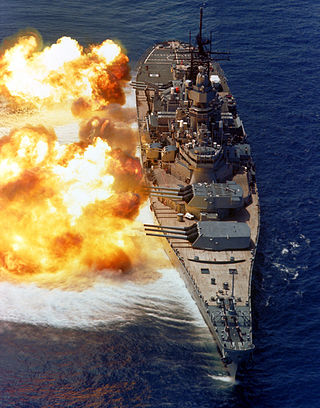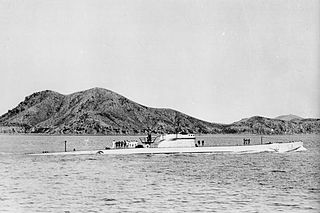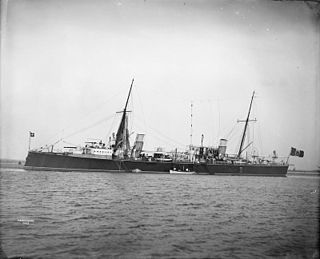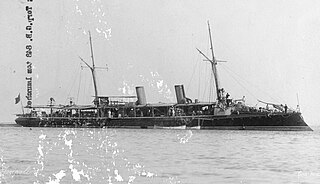
A battleship is a large armored warship with a main battery consisting of large caliber guns. It dominated naval warfare in the late 19th and early 20th centuries.
USS Virginia may refer to:

A monitor is a relatively small warship that is neither fast nor strongly armored but carries disproportionately large guns. They were used by some navies from the 1860s, during the First World War and with limited use in the Second World War.

A warship or combatant ship is a ship that is built and primarily intended for naval warfare. Usually they belong to the armed forces of a nation. As well as being armed, warships are designed to withstand damage and are typically faster and more maneuverable than merchant ships. Unlike a merchant ship, which carries cargo, a warship typically carries only weapons, ammunition and supplies for its crew. Warships usually belong to a navy, though they have also been operated by individuals, cooperatives and corporations.
Seven vessels of the British Royal Navy have been named HMS Valiant.

The Italian Navy is the navy of the Italian Republic. It is one of the four branches of Italian Armed Forces and was formed in 1946 from what remained of the Regia Marina after World War II. As of August 2014, the Italian Navy had a strength of 30,923 active personnel, with approximately 184 vessels in service, including minor auxiliary vessels. It is considered a multiregional and a blue-water navy.

The Regia Marina (RM) or Royal Italian Navy was the navy of the Kingdom of Italy from 1861 to 1946. In 1946, with the birth of the Italian Republic, the Regia Marina changed its name to Marina Militare.

Benedetto Brin was an Italian naval administrator and politician. He played a major role in modernizing and expanding the Italian Regia Marina from the 1870s to the 1890s, designing several major classes of warships, including the large ironclad warships of the Duilio, Italia, and Re Umberto classes, the pre-dreadnought battleships of the Ammiraglio di Saint Bon and Regina Margherita classes, and the armored cruisers of the Vettor Pisani and Giuseppe Garibaldi classes. His contributions to Italian naval power were marked by the naming of the second Regina Margherita-class battleship as Benedetto Brin, among other commemorations.

The Marcello class was a class of nine submarines built in 1937 and 1938 by CRDA in Trieste for the Royal Italian Navy. Two similar submarines built in 1939 at La Spezia by Oto Melara are sometimes considered part of the class. All eleven served in the Mediterranean Sea at the start of the Second World War. After Provana's 1940 sinking, the remaining boats were transferred to the BETASOM Atlantic submarine base at Bordeaux in August 1940. After four boats had been sunk in the Atlantic, Barbarigo and Comandante Cappellini were then selected for conversion to "transport submarines" in order to exchange rare or irreplaceable trade goods with Japan. Cargo capacity of 160 tons reduced reserve buoyancy from 20–25% to 3.5–6%; and armament was reduced to defensive machine guns. Only Dandolo was in operational condition at the end of the war.

The QF 3-pounder Hotchkiss or in French use Canon Hotchkiss à tir rapide de 47 mm were a family of long-lived light 47 mm naval guns introduced in 1886 to defend against new, small and fast vessels such as torpedo boats and later submarines. There were many variants produced, often under license which ranged in length from 32 to 50 calibers but 40 caliber was the most common version. They were widely used by the navies of a number of nations and often used by both sides in a conflict. They were also used ashore as coastal defense guns and later as an anti-aircraft gun, whether on improvised or specialized HA/LA mounts.

The Ruggiero di Lauria class was a class of ironclad battleships built for the Italian Regia Marina during the late 19th century. The three ships—Ruggiero di Lauria, Francesco Morosini, and Andrea Doria–were improved versions of the earlier Duilio-class ironclads. The primary improvements were new breech-loading guns, better armor protection, and more powerful machinery. The ships, designed by Giuseppe Micheli, marked a temporary diversion from the ideas of Benedetto Brin, who had designed the two preceding classes along with the following class.

Ruggiero di Lauria was an ironclad battleship built in the 1880s for the Italian Regia Marina. She was the lead ship of the Ruggiero di Lauria class, which included two other ships, Francesco Morosini and Andrea Doria. Ruggiero di Lauria, named for the medieval Sicilian admiral Ruggiero di Lauria, was armed with a main battery of four 432 mm (17 in) guns, was protected with 451 mm (17.75 in) thick belt armor, and was capable of a top speed of 17 knots.

Francesco Morosini was an ironclad battleship built in the 1880s and 1890s for the Italian Regia Marina. The ship, named for Francesco Morosini, the 17th-century Doge of Venice, was the second of three ships in the Ruggiero di Lauria class, along with Ruggiero di Lauria and Andrea Doria. She was armed with a main battery of four 356 mm (14 in) guns, was protected with 451 mm (17.75 in) thick belt armor, and was capable of a top speed of 17 knots.

Calatafimi was a torpedo cruiser of the Partenope class built for the Italian Regia Marina in the 1880s. She was built by the Cantiere navale fratelli Orlando shipyard; her keel was laid in July 1891, she was launched in May 1894, and was commissioned in December 1895. Her main armament were her five torpedo tubes, which were supported by a battery of eleven small-caliber guns. Calatafimi spent most of her career in the main Italian fleet, where she was primarily occupied with training exercises. The ship was sold in March 1907 and broken up for scrap.

Tripoli was the first modern torpedo cruiser built for the Italian Regia Marina. She was built by the Regio Cantiere di Castellammare di Stabia shipyard in 1885–86. The only vessel of her class, she provided the basis for the Goito and Partenope classes that followed. She was armed with five 14-inch (356 mm) torpedo tubes and a battery of light guns, and was capable of a top speed of 17.5 knots. Tripoli spent her career in the main Italian fleet, where she was occupied primarily with peacetime training exercises. She was modernized several times throughout her career, and in 1910, was converted into a minelayer, a role she served in for another thirteen years, including during World War I. She was the longest serving torpedo cruiser in the Italian fleet, with over 36 years in service by the time she was discarded in March 1923.

The Thaon di Revel class is a class of multipurpose offshore ships built by Fincantieri for the Italian Navy.
It is planned to replace four Soldati-class light patrol frigates and eight Minerva-class corvettes between 2021/2035. As part of the 2014 Naval Law, a total of sixteen ships are planned and as of 2019 seven vessels have been financed with three more on option.
Francesco Caracciolo or Ammiraglio Caracciolo or simply Caracciolo was the name of at least two ships of the Italian Navy named in honour of Francesco Caracciolo and may refer to:
Marcantonio Colonna was the name of at least three ships of the Italian Navy named in honour of Marcantonio Colonna and may refer to:
Three naval vessels of Japan have been named Fusō:

Francesco Morosini (P431) is the second ship of Paolo Thaon di Revel-class offshore patrol vessel.












